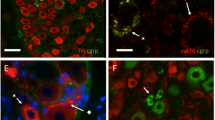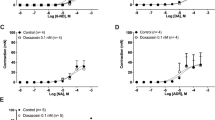Summary
-
1.
The localization of catecholamines and 5-hydroxytryptamine has been investigated in the human testis, epididymis, ductus deferens and prostate obtained at operations on patients aged 26–79 years.
-
2.
In fluorimetric determinations noradrenaline was found to be present in varying concentrations in the genital tract. The lowest amount (0.07 μg/g) was found in the testis. In proximal direction along the ejaculatory duct system there was a progressive increase in the noradrenaline level, reaching a maximum of 1.43 μg/g in ductus deferens. The prostatic tissue (obtained from hyperplastic glands) contained only 0.15 μg/g noradrenaline.
No dopamine was present. Adrenaline occurred, by all probability as an artefact, only in tissues from one single case to which this amine had been administered as part of the local anaesthetic mixture given before operation.
-
3.
Fluorescence microscopic analysis of formaldehyde-treated genital organs revealed the presence of adrenergic nerves, the number of which well agreed with the noradrenaline concentrations.
Only vascular nerves were found in the testis. The bulk of the adrenergic nerve terminals in the epididymis, ductus deferens and prostate innervated the smooth muscle coats, whereas only a smaller portion of the adrenergic nerve population was of vasomotor nature.
-
4.
Microspectrophotometric characterization of the formaldehyde-induced fluorescence in the tissue sections confirmed that the adrenergic nerves contained noradrenaline.
-
5.
The finding of fluorescent ganglion cells in the prostate indicated that part — if not all — of the male genital tract also in humans is innervated by way of so-called short adrenergic neurons, originating in peripherally located sympathetic ganglia.
-
6.
Flask-shaped cells, morphologically resembling the enterochromaffin cells and emitting a yellow indole fluorescence, were present in the epithelium of the prostatic mucosa.
-
7.
Apart from the specific, formaldehyde-induced monoamine fluorescence, a considerable amount of autofluorescence of varying colour and related to different structures occurred both in the epithelial layers and in the connective tissue.
Similar content being viewed by others
References
Baumgarten, H. G.: Über die Verteilung von Catecholaminen im Darm des Menschen. Z. Zellforsch. 83, 133–146 (1967).
-, A. F. Holstein: Fluoreszierende Sphaeridien in Zellkernen des menschlichen Nebenhodenepithels. To be published (1968).
Bertler, A., A. Carlsson, E. Rosengren and B. Waldeck: A method for the fluorimetric determination of adrenaline, noradrenaline and dopamine in tissues. Kgl. Fysiogr. Sällsk. Lund Förh. 28, 121–123 (1958).
Björklund, A., B. Ehinger, and B. Falck: A method for differentiating dopamine from noradrenaline by microspectrofluorometry. J. Histochem. Cytochem. (1968) (in press).
Corrodi, H., N.-A. Hillarp, and G. Jonsson: Fluorescence methods for the histochemical demonstration of monoamines. 3. Sodium borohydride reduction of the fluorescent compounds as a specificity test. J. Histochem. Cytchem. 12, 582–586 (1964).
—, and G. Jonsson: The formaldehyde fluorescence method for the histochemical demonstration of biogenic monoamines. J. Histochem. Cytochem. 15, 65–78 (1967).
Euler, U. S. v.: An adrenaline like action in extracts from the prostate and related glands. J. Physiol. (Lond.) 81, 102–112 (1934).
—: Noradrenaline. Springfield (Ill): Charles C. Thomas Publ. Co. 1956.
—: Neurotransmission in the adrenergic nervous system. Harvey Lect. Ser. 55, 43–65 (1961).
—, and F. Lishajko: A specific kind of noradrenaline granules in the vesicular gland and the vas deferens of the bull. Life Sci. 5, 687–691 (1966).
Falck, B.: Observations on the possibilities of the cellular localization of monoamines by a fluorescence method. Acta physiol. scand. 56, Suppl. 197, 1–25 (1962).
—, J. Häggendal, and Ch. Owman: The localization of adrenaline in adrenergic nerves in the frog. Quart. J. exp. Physiol. 48, 253–257 (1963).
—, N. A. Hillarp, G. Thieme, and A. Torp: Fluorescence of catecholamines and related compounds condensed with formaldehyde. J. Histochem. Cytochem. 10, 348–354 (1962).
—, and Ch. Owman: A detailed methodological description of the fluorescence method for the cellular demonstration of biogenic monoamines. Acta Univ. Lund. II, 7, 1–23 (1965).
— —, and N. O. Sjöstrand: Peripherally located adrenergic neurons innervating the vas deferens and the seminal vesicle of the guinea-pig. Experientia (Basel) 21, 98–100 (1965).
Forsberg, J.-G., E. Rosengren, and N. O. Sjöberg: On the occurrence of 5-hydroxytryptamine containing cells in the vaginal and vestibular epithelium of the rabbit. Z. Zellforsch. 63, 302–308 (1964).
Gomori, G.: Observations with differential stains on human islets of Langerhans. Amer. J. Path. 17, 395–406 (1941).
Häggendal, J.: An improved method for fluorimetric determination of small amounts of adrenaline and noradrenaline in plasma and tissues. Acta physiol. scand. 59, 242–254 (1963).
Hamberger, B., T. Malmfors, and Ch. Sachs: Standardization of paraformaldehyde and of certain procedures for the histochemical demonstration of catecholamines. J. Histochem. Cytochem. 13, 147 (1965).
Holstein, A. F.: Die glatte Muskulatur in der Tunica albuginea des Hodens und ihr Einfluß auf den Spermatozoentransport in den Nebenhoden. Anat. Anz., Erg.-Bd. 121, 103–108 (1968).
—: Morphologische Studien am Nebenhoden des Menschen. In: Zwanglose Abhandlungen aus dem Gebiet der normalen und pathologischen Anatomie, hrsg. v. W. Bargmann u. W. Doerr. Stuttgart: Georg Thieme 1968 (im Druck).
Jacobowitz, D., and G. B. Koelle: Histochemical correlations of AcChE and catecholamines in postganglionic autonomic nerves of the cat, rabbit and guinea-pig. J. Pharmacol. exp. Ther. 148, 225–237 (1965).
Jarvik, M. E.: Drugs used in the treatment of psychiatric disorders. I. The phenothiazine derivatives. In: Goodman and Gilman, The Pharmacological Basis of Therapeutics, p. 159–178. New York: Macmillan & Co. 1965.
Langley, J. N., and H. K. Anderson: The innervation of the pelvic and adjoining viscera. J. Physiol. (Lond.) 19, 71–139 (1895).
Leidl, W.: Vergleichende andrologische Betrachtungen aus dem Gebiete der Veterinär- und Humanmedizin. In: Neue Ergebnisse der Andrologie, S. 1–7. Berlin-Heidelberg-New York: Springer 1965.
Nickerson, M.: Drugs inhibiting adrenergic nerves and structures innervated by them. In: Goodman and Gilman, The Pharmacological Basis of Therapeutics, p. 546–572. New York: Macmillan & Co. 1965.
Norberg, K. A.: Transmitter histochemistry of the sympathetic adrenergic nervous system. Brain Res. 5, 125–170 (1967).
—, P. L. Risley, and U. Ungerstedt: Adrenergic innervation of the male reproductive ducts in some mammals. Z. Zellforsch. 76, 278–286 (1967).
Owman, Ch., E. Rosengren, and N. O. Sjöberg: Adrenergic innervation of the human female reproductive organs: A histochemical and chemical investigation. Obstet. Gynec. 30, 763–773 (1967).
—, and N. O. Sjöberg: Difference in rate of depletion and recovery of noradrenaline in „short“ and „long“ sympathetic nerves after reserpine treatment. Life Sci. 6, 2549–2556 (1967).
—, and N. O. Sjöstrand: Short adrenergic neurons and catecholamine-containing cells in vas deferens and accessory male genital glands of different mammals. Z. Zellforsch. 66, 300–320 (1965).
— —: On short adrenergic neurons in the accessory male genital organs of the bull. Experientia (Basel) 22, 759–761 (1966).
Ritzén, M.: Cytochemical identification and quantitation of biogenic monoamines. M. D. Thesis Stockholm 1967. Stockholm: Norstedt & Söner 1967.
Romeis, B.: Mikroskopische Technik. München: Oldenbourg 1968.
Sjöstrand, N. O.: Effect of reserpine and hypogastric denervation on the noradrenaline content of the vas deferens and seminal vesicle of the guinea-pig. Acta physiol. scand. 56, 376–380 (1962).
—: The adrenergic innervation of the vas deferens and the accessory male genital glands. Acta physiol. scand. 65, Suppl. 257, 1–82 (1965).
—, and G. Swedin: Effect of reserpine on the noradrenaline content of the vas deferens and seminal vesicle compared with the submaxillary gland and the heart of the rat. Acta physiol. scand. 72, 370–371 (1968).
Stjärne, L., and F. Lishajko: Comparison of spontaneous loss of catecholamines and ATP in vitro from isolated bovine adrenomedullary, vesicular gland, vas deferens and splenic nerve granules. J. Neurochem. 13, 1213–1216 (1966).
Author information
Authors and Affiliations
Additional information
Supported by grant No. B68-12X-732-03B from the Swedish Medical Research Council, by the Deutsche Forschungsgemeinschaft (Ba 310/1; Fl, 26/12), and by Ford Foundation, New York.
Rights and permissions
About this article
Cite this article
Baumgarten, H.G., Falck, B., Holstein, A.F. et al. Adrenergic innervation of the human testis, epididymis, ductus deferens and prostate: a fluorescence microscopic and fluorimetric study. Z. Zellforsch 90, 81–95 (1968). https://doi.org/10.1007/BF00496704
Received:
Issue Date:
DOI: https://doi.org/10.1007/BF00496704




